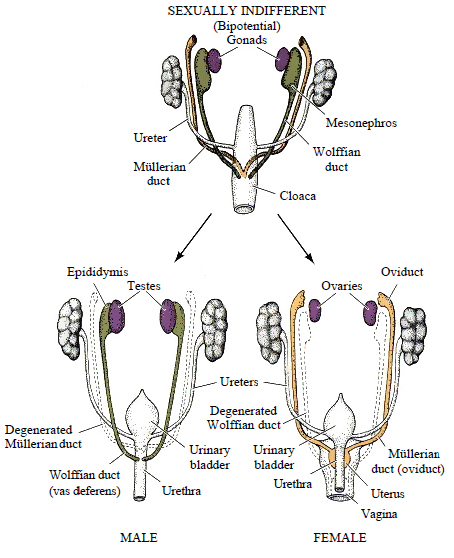- Reproductive System Quizlet
- Links Reproductive System Homeostasis
- Male Reproductive System
- Reproductive System Function
This is an extensive presentation of pictures of bovine embryos. The embryos have been photographed at three magnifications and with two different types of microscopes. The photos are clear and well marked with arrows or other enhancements which clearly define points of interest. The embryos are graded with the IETS system. This website has information about the female reproductive system that is more for kids. The terms are well explained and the information is easy to understand. The website include the anatomy, what reproduction is, and how menstruation work for girls.
Hermaphrodite Definition
A hermaphrodite is an organism with both male and female genitalia. In sexually reproducing organisms, males have organs that produce male gametes, usually sperm. Females have different sexual organs that produce female gametes, usually called eggs.
hermaphrodite
having both male and female reproductive organs in one individual; also known as monecious; contrast to diecious
Source: Noland, George B. 1983. General Biology, 11th Edition. St. Louis, MO. C. V. Mosby ..
Hermaphrodite is used in botany to describe a flower that has both staminate (male, pollen-producing) and carpelate (female, seed-producing) parts. Other terms for this condition are bisexual and perfect.
~
Posted by Leslie Samuel
/hÉrËmafrÉdÄ't/â Noun, pl. ~s 1. An organism that has reproductive organs normally associated with both male and female sexes (wikipedia.org); an organism having both male and female organs, therefore, is capable of producing both male and female gametes.
~ An organism with both male and female functional reproductive organs. Hermaphroditism may refer to an aberration in unisexual animals; monoecy implies that this is the normal condition for the species.
~ An organism that has both male and female gonads.
~
(her-maf-roh-dite) [Gk. Hermes and Aphrodite]
An individual that functions as both male and female in sexual reproduction by producing both sperm and eggs.
Be tech helphome. heterochromatin ..
~.
Sometimes ~. Mainly separate sexes in separate individuals.
~.
~s still reproduce sexually by cross-fertilizing each other's ova. In any case, the variety of reproductive methods and developmental processes that exist in the animal world are too numerous to fully cover here, so we're going to focus on vertebrate development with a special emphasis on human development.
~ species of animals and plants carry out cross-fertilization mainly due to the maturation of female and male structures at different periods.
Some ~s can self-fertilize, but most mate with another member of the same species.
In such matings, each individual receives and donates sperm.
This results in twice as many offspring as would be produced if only one set of eggs were fertilized.
Usually ~s are sequential, meaning they can switch sex, usually from female to male (protogyny). This can happen if a dominant male is removed from a group of females. The largest female in the harem can switch sex over a few days and replace the dominant male.
An adult ~ 6.4 properties of definite integralsap calculus calculator. C. elegans worm
Scientific classification
Kingdom:
Animalia ..
Reproductive System Quizlet

Sequential ~. An individual that sequentially produces male and then female gametes or vice versa
Sessile. Immobile because of an attachment to a substratum
Seston. Particulate matter suspended in seawater ..
~: (hermaphroditic, ~s) An organism which has both female and male reproductive organs and is therefore capable of producing both eggs and sperms. A simultaneous ~ has both kinds of reproductive organs at the same time.
Adaptations that prevent self-fertilization include self-incompatibility (genetic recognition and blocking of self-pollen) and dioecy (separate male and female individuals). Adaptations that reduce the chances of self-pollination in ~s include separation of the anthers and stigma in space (herkogamy) ..
(Also, every individual in a ~population is able to produce offspring, which is not the case in populations with separate sexes.) A disadvantage might be that ~ populations are less efficient because they do not specialize in one sex or another, ..
Caenorhabditis elegans: A normally self-fertilizing ~ soil nematode whose developmental genetics has been extensively studied. It is no more than 1 mm long. Loss of an X chromosome by meiotic disjunction leads to the production of males. The genetic basis of apoptosis was first shown in C.
Links Reproductive System Homeostasis
~ â (â links)
Gene transfer â (â links)
Basidium â (â links)
Puberty â (â links)
Digenesis â (â links)
Asexual reproduction â (â links)
Dumposome â (â links)
Spermatozoan â (â links)
Amphimixis â (â links)
Reproductive system â (â links) ..
The lack of balding in eunuchs, pseudo ~s and individuals with insensitivity syndrome to androgens confirms the fact that androgens are a prerequisite for common baldness. As there is a difference in the pattern of hair loss in men and women, the terms to differentiate them i.e.
In fact, all normal individuals have the same number of cells: 959 somatic cells in the ~ and 1,031 in the male. Unlike Drosophila and mammals, which have extensive cell movement during development, the cells of C. elegans do not move very much during development. All of these features made C.
See also: What is the meaning of Organ, Animal, Species, Animals, Trans?| ◄ Herkogamy | Hermaphroditism ► |

The Link Foundation proudly offers
for PhD students in areas that Modeling, Simulation, and Training.
Deadline to apply: January 15 (11:59 pm EST)Submit Application
Male Reproductive System

The Link Foundation Modeling, Simulation, and Training Program was put in place with the following objectives:
- To foster advanced level research in modeling, simulation, and training
- To enable Ph.D. students the freedom to work on their research full time
- To disseminate the results of that research through conferences, journals, and other publications.
Reproductive System Function
The Link Foundation also offers fellowships in the areas of energy production and utilization; and in the area of ocean engineering.
